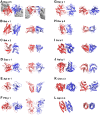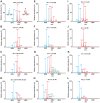Transient dimers of allergens
- PMID: 20140203
- PMCID: PMC2816702
- DOI: 10.1371/journal.pone.0009037
Transient dimers of allergens
Abstract
Background: Allergen-mediated cross-linking of IgE antibodies bound to the FcepsilonRI receptors on the mast cell surface is the key feature of the type I allergy. If an allergen is a homodimer, its allergenicity is enhanced because it would only need one type of antibody, instead of two, for cross-linking.
Methodology/principal findings: An analysis of 55 crystal structures of allergens showed that 80% of them exist in symmetric dimers or oligomers in crystals. The majority are transient dimers that are formed at high protein concentrations that are reached in cells by colocalization. Native mass spectrometric analysis showed that native allergens do indeed form transient dimers in solution, while hypoallergenic variants of them exist almost solely in the monomeric form. We created a monomeric Bos d 5 allergen and show that it has a reduced capability to induce histamine release.
Conclusions/significance: The results suggest that dimerization would be a very common and essential feature for allergens. Thus, the preparation of purely monomeric variants of allergens could open up novel possibilities for specific immunotherapy.
Conflict of interest statement
Figures



Similar articles
-
Allergenicity and antigenicity of wild-type and mutant, monomeric, and dimeric carrot major allergen Dau c 1: destruction of conformation, not oligomerization, is the roadmap to save allergen vaccines.J Allergy Clin Immunol. 2007 Apr;119(4):944-51. doi: 10.1016/j.jaci.2006.11.699. Epub 2007 Feb 9. J Allergy Clin Immunol. 2007. PMID: 17292955
-
Dimerization of lipocalin allergens.Sci Rep. 2015 Sep 8;5:13841. doi: 10.1038/srep13841. Sci Rep. 2015. PMID: 26346541 Free PMC article.
-
Structural aspects of dog allergies: the crystal structure of a dog dander allergen Can f 4.Mol Immunol. 2014 Sep;61(1):7-15. doi: 10.1016/j.molimm.2014.04.003. Epub 2014 May 21. Mol Immunol. 2014. PMID: 24859823
-
Structural Aspects of the Allergen-Antibody Interaction.Front Immunol. 2020 Sep 2;11:2067. doi: 10.3389/fimmu.2020.02067. eCollection 2020. Front Immunol. 2020. PMID: 32983155 Free PMC article. Review.
-
High pressure effects on allergen food proteins.Biophys Chem. 2013 Dec 15;183:19-29. doi: 10.1016/j.bpc.2013.06.009. Epub 2013 Jun 21. Biophys Chem. 2013. PMID: 23850175 Review.
Cited by
-
Development of β-lactoglobulin-specific chimeric human IgEκ monoclonal antibodies for in vitro safety assessment of whey hydrolysates.PLoS One. 2014 Aug 25;9(8):e106025. doi: 10.1371/journal.pone.0106025. eCollection 2014. PLoS One. 2014. PMID: 25153680 Free PMC article.
-
Specific region affects the difference in accumulation levels between apple food allergen Mal d 1 and birch pollen allergen Bet v 1 which are expressed in vegetative tissues of transgenic rice.Plant Mol Biol. 2018 Nov;98(4-5):439-454. doi: 10.1007/s11103-018-0789-7. Epub 2018 Oct 22. Plant Mol Biol. 2018. PMID: 30350245
-
Filling the Antibody Pipeline in Allergy: PIPE Cloning of IgE, IgG1 and IgG4 against the Major Birch Pollen Allergen Bet v 1.Int J Mol Sci. 2020 Aug 8;21(16):5693. doi: 10.3390/ijms21165693. Int J Mol Sci. 2020. PMID: 32784509 Free PMC article.
-
Impact of Enolase in Allergic Disease.Curr Allergy Asthma Rep. 2024 Oct;24(10):571-579. doi: 10.1007/s11882-024-01170-w. Epub 2024 Aug 21. Curr Allergy Asthma Rep. 2024. PMID: 39167280 Free PMC article. Review.
-
Alternaria alternata allergen Alt a 1: a unique β-barrel protein dimer found exclusively in fungi.J Allergy Clin Immunol. 2012 Jul;130(1):241-7.e9. doi: 10.1016/j.jaci.2012.03.047. Epub 2012 Jun 2. J Allergy Clin Immunol. 2012. PMID: 22664167 Free PMC article.
References
-
- Gould HJ, Sutton BJ. IgE in allergy and asthma today. Nature Rev Immunol. 2008;8:205–217. - PubMed
-
- Mari A, Scala E, Palazzo P, Ridolfi S, Zennaro D, et al. Bioinformatics applied to allergy: Allergen databases, from collecting sequence information to data integration. The allergome platform as a model. Cell Immunol. 2006;244:97–100. - PubMed
-
- Radauer C, Bublin M, Wagner S, Mari A, Breiteneder H. Allergens are distributed into few protein families and possess a restricted number of biochemical functions. J All Clin Immunol. 2008;121:847–852. - PubMed
-
- Niemi M, Jylhä S, Laukkanen ML, Söderlund H, Mäkinen-Kiljunen S, et al. Molecular interactions between a recombinant IgE antibody and the β-lactoglobulin allergen. Structure. 2007;15:1413–1421. - PubMed
-
- Nooren IMA, Thornton JM. Structural characterization and functional significance of transient protein-protein interactions. J Mol Biol. 2003;325:991–1018. - PubMed
Publication types
MeSH terms
Substances
LinkOut - more resources
Full Text Sources
Other Literature Sources

